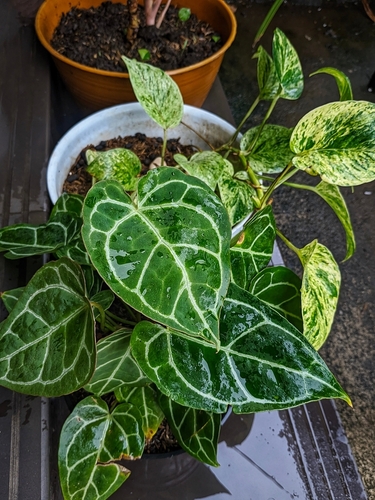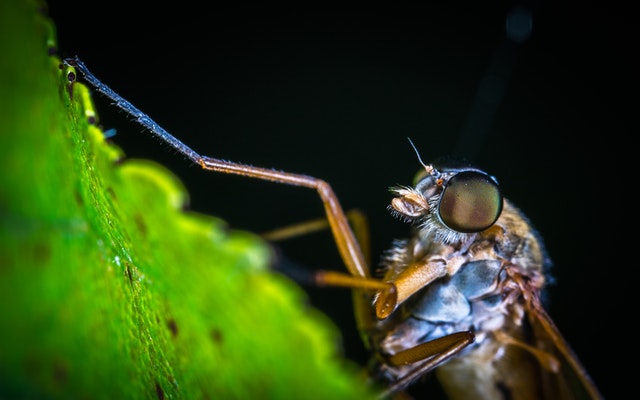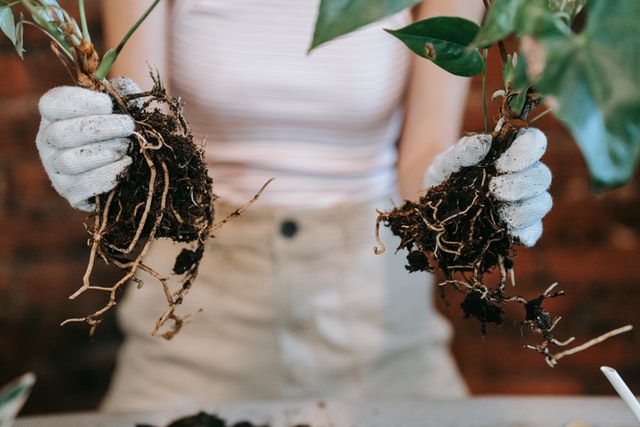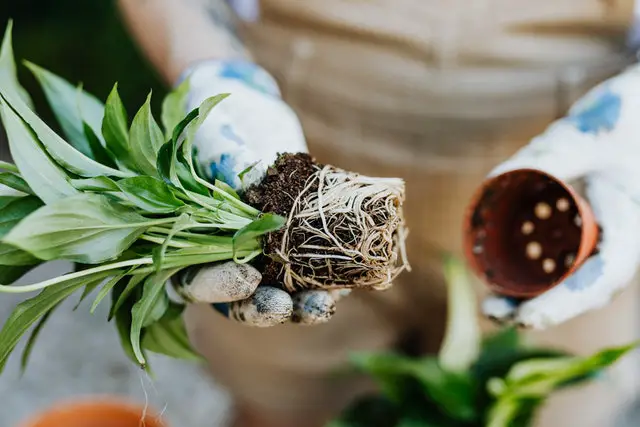The Anthurium Crystallinum is known for its gorgeous heart-shaped leaves with white veins. The velvety foliage could be dark green or reddish-purple.
Compared to other, more common plants, this delightful houseplant is a little more uncommon, but it is extremely lovely and makes a lovely accent to an indoor garden.
This species of plant is evergreen, which means that it maintains its beauty all year round. It is a tropical plant that can be placed both in the garden and inside the house. Keep on reading to learn more about this exquisite plant!
Similar posts:
- Amphioxus Begonia Plant, Grow & Care Guide 2022
- Aglaonema Pictum Bicolor Plant, Grow & Care Guide 2022
- Philodendron Verrucosum Types, Plant, Grow & Care Guide 2022
What is Anthurium Crystallinum plant?

The Anthurium Crystallinum is a perennial flowering plant in the Araceae family that is endemic to the rainforests of Central and South America, from Panama to Peru.
It grows to about 90 centimeters (35 inches) tall and has large, velvety oval leaves with prominent silvery-white veins and flowers with spathes and pale spadices all year. The inflorescences have a faint but pleasant fragrance. The berries are purple with a tinge of white. New leaves on the plant emerge as a copper color.
It is said that the name “crystallinum” derives from the glimmer on the leaves when observed up close in bright light – they sparkle as if they are made of tiny crystals. It is also called Crystal Anthurium and Crystal Laceleaf. The Anthurium Crystallinum was awarded the Royal Horticultural Society’s Award of Garden Merit (AGM).
Origin and Classification
The Anthurium Crystallinum is both an epiphyte and terrestrial plant from the Araceae family. An epiphyte is a plant that thrives on another plant, while terrestrial flourishes on the surfaces of rocks and hills.
It originated from the perimeters of the rainforests of Central and South America, from Panama to Peru. It was discovered in Colombia in the late 1800s, according to Dr. Thomas B. Croat’s journal.
However, since that time, no type of specimen in Colombia that exactly matched the original description has ever been discovered or observed.
The Anthurium Crystallinum with a closed sinus is quite unusual, but there are several plant collectors that have that specific kind of specie, which was a good match for the painting done by Linden and Andre. The Anthurium species vary greatly, and not every leaf of every specimen will always look exactly the same.
Features of Anthurium Crystallinum Plant
The Anthurium Crystallinum is a popular indoor plant mostly grown for its foliage rather than its flowers. It has attractive, oval dark green leaves with deep white veins. Let’s take a closer look at this plant’s unique features.
1. Leaves

Perhaps the most striking feature of this exquisite evergreen is its velvety foliage. They are heart-shaped with a dark green color but could also be reddish-purple with stunning white venation, which seems to glimmer when sunlight touches it. When your plant is healthy, you can expect it to produce new leaves every 4-5 weeks.
2. Flowers
The Anthurium Crystallinum’s flowers can blossom all year round given the right tropical conditions. However, some people do not care so much for its flowers. The berries are purple with hints of white and the flowers can bloom at any time of year in perfect conditions. The spadix has a delicate, pleasant aroma.
3. Size
The Anthurium Crystallinum can reach a height of 30 to 60 inches. It grows to a width of 15 to 20 inches at maturity. Its growing season is from spring to summer. It has a slow to moderate development rate and self-heading growth pattern.
4. Toxicity
Anthuriums contain insoluble calcium oxalate crystals that are poisonous to pets when ingested. It can cause tissue penetration and irritation to the mouth and GI tract. Swelling of the upper airway can even cause difficulties to breathe in rare cases.
Common symptoms are drooling, a decrease in appetite, and vomiting. Keep this plant out of reach of young children and pets.
5. Dormancy
Light, humidity, and temperature are critical elements for plant growth. Your Anthurium Crystallinum may appear dormant until spring arrives since those components often decrease throughout the winter.
Additionally, it’s essential to provide your plant with the proper amount of nourishment and moisture so that it may grow new roots, leaves, and stems.
Basic Care of Anthurium Crystallinum Plant

The Anthurium Crystallinum is a relatively easy plant to grow and maintain. However, you should still pay attention to the ideal conditions for this evergreen to last a long time. We provide you with a thorough manual to help you make sure it is getting the proper care it needs.
1. Size and Growth
The Anthurium Crystallinum has a slow to moderate growth rate. However, as a young plant, it is quite a fast grower. It develops a single leaf every 4 to 6 weeks. New small copper-colored leaves would grow in just a couple of weeks to full size.
They have a self-heading growth pattern. The plant grows approximately 20 inches every two to five years. It reaches between 30 and 60 inches in height and 15 to 20 inches in width at maturity. The growing season is spring to summer.
2. Light Requirements
As an epiphyte, the Anthurium crystallinum grows in the shade of other plants and trees in its natural environment, as such, it loves shade. Prolonged exposure to direct sunlight will scorch its foliage. Allow them to develop in a suitable, shaded spot.
Don’t completely rob them of sunlight, though. The ideal shade is between 75 and 80 percent. Bright yet indirect light would be best for this lovely plant to be healthy. You may situate it about 5 to 8 feet away from a window.
If you are wary about how much light your plant is getting and you’re using grow lights, you may download a light meter app to measure the amount of light it is receiving.
3. Water Requirements
During the summer, it is advisable to water your plant 2 to 3 times a week. In winter, once every ten days or two weeks would be enough. Make sure that you water your plant adequately but not overly. Excessive watering can cause root rot that can kill your precious plant. Allow the soil to dry out between waterings.
4. Soil Requirements
The optimal soil conditions for the Anthurium Crystallinum to thrive in are good aeration, sufficient water retention, and adequate drainage. It should be able to anchor the roots so that the plant would stay upright as it grows bigger.
Moreover, it should provide enough nutrients. Excellent media can be composed of organic matter (nut shells, wood shavings, sugar cane bagasse) and light soil mixes work best and some gardeners also use artificial media such as rockwool and polyphenol foam.
5. Temperature and Humidity
The Anthurium Crystallinum flourishes in humid and warm conditions, and its ideal temperature is between 70 to 80 degrees Fahrenheit or 19 to 26 degrees Celsius. You should always keep it inside during the winter because your plant will freeze if the temperature falls below these ranges.
It also prefers stable temperatures, so keep it away from heat ducts, ventilator grills, and drafts. This plant loves humidity, so keep it high at 70-80%. You may mist the leaves with water or use a humidifier to help with the humidity.
Some plant owners place it in the kitchen or bathroom where the humidity is typically high. But do keep in mind that if it’s located in the bathroom, there should be a window where the sunlight passes through.
6. Pest and Disease Resistance

Generally, the Anthurium Crystallinum is a pest and disease-resistant plant, but there can be issues every now and then. To prevent infections, maintain a healthy plant overall and keep its surroundings clean.
Mealy bugs, aphids, thrips, and scales are common pests that infest these plants. If you observe any of these pests, apply a solution of two tablespoons of neem oil or mild liquid soap.
It can also be infected by bacteria and fungi, which can cause leaf spots. If you see irregular blotches, sunken black holes, and small dark spots, then they can be an indication that your plant has been infected. You may use a chemical fungicide in this instance. However, if the damage is only superficial, it might not be worth it.
7. Fertilizing
Chemical fertilizers might be too harsh, so you must choose which one to use carefully. They shouldn’t be used more than twice a month. It is preferable to use a slow-time release or liquid fertilizer. Be sure to check the soil regularly since the salt from fertilizers could damage your plant.
Alternatively, some growers opt for organic fertilizer, such as garden leftovers, crushed shells, and wood shavings.
8. Potting and Repotting
When selecting a pot for your plant, choose one with a good drainage system, to allow the roots to breathe well and prevent them from rotting from excess water retention. A terracotta pot is highly recommended.
As a young plant, the Anthurium Crystallinum grows fast and may need more repottings, but as it matures and its growth rate slows down, it will need fewer repottings. If you notice that the pot is too small for its roots, you may repot (every two years).
Always be careful in handling the roots while transplanting the plant. Don’t forget to use a good organic soil mixture.
9. Pruning Requirements
The Anthurium Crystallinum doesn’t require frequent pruning. Prune it from the top going down and cut off any dead or discolored leaves. Remember to use sterilized shears.
How to Propagate Anthurium Crystallinum

There are three methods for propagating the Anthurium Crystallinum:
· Root Separation
· Seeds
· Stem Cuttings
Propagating from seeds requires perfect conditions, much like its natural environment in rainforests, to mature properly. Using stem cuttings could be tricky as well. Thus, the best way would be through root separation, which we would discuss further.
Step 1
Make sure your plant’s roots and overall structure are sturdy before starting. Put off the propagation for a month or two if they are still very delicate.
Step 2
Gently remove the soil until you are close enough to the thick root, which is typically in the middle.
Step 3
Get close to all the roots that are emerging from the thickest one, and then separate them into two. Be extremely cautious when dividing the plant because each section should have its own roots.
Step 4
Plant them each in two separate terracotta pots.
Step 5
Make sure that the soil of the propagated section is kept sufficiently warm and moist.
Step 6
You can add some organic or artificial fertilizer after a day or two to help your plant start developing more quickly. Once a week should be enough.
Step 7
When your plant finally begins to grow, reduce to fertilizing once or twice every month.
Common Problems Caring for Anthurium Crystallinum
Even though the Anthurium Crystallinum is generally easy to cultivate, you may still encounter some issues. The following are some common problems in caring for this exotic plant.
1. Curling Leaves
Curling leaves can be caused by several factors such as pests, abrupt temperature fluctuations, excessive watering, insufficient sunlight, low humidity, and other elements.
Ensure that your plant has the right conditions with a stable warm temperature, adequate bright, indirect light, high humidity, and proper drainage. Don’t let it soak heavily in water as well. Inspect for any signs of pests.
2. Black Nose Disease
The fungus Colletotrichum gloeosporioides attacks the floral spadix (nose) of the Anthurium Crystallinum and causes noticeable small brown to black flecks. They get larger quickly, become watery, and may completely cover the spadix until it falls off.
Fungicides containing mancozeb would be effective in eliminating this disease. Recently, plant breeders have integrated disease resistance in these plant varieties.
3. Bacterial Blight
The bacteria infiltrate the plant through pores along the margin of the leaf. They can also enter through torn tissues and punctures by insects.
Once a plant is infected, it spreads swiftly. It can make the leaf appear bronze in color and eventually cause the plant to wilt. A combination of copper and fungicides with mancozeb may be used.
4. Root Rot

Root rot can be caused by fungal infections and excessive watering. Some plants may be more prone to rotting due to inadequate light or fertilizer levels. The most well-known pathogens that can cause it are Rhizoctonia, Pythium, and Phytophthora.
It develops underground, so it usually remains undetected until it is too late. Often, plants that have suffered significant rotting cannot be rescued. Always inspect the soil to see whether a plant needs watering before doing so to avoid overwatering.
Similarly, if watering from the bottom up, avoid letting plants sit in water for an extended period of time. Make sure that the pot also has good drainage.
Outro
Don’t get intimidated by this gorgeous plant with heart-shaped leaves. It is relatively easy to cultivate and maintain if you follow the right conditions. Remember it thrives in high humidity, warm temperatures, bright but indirect light, and plenty of water. It can be a slow grower as it matures, so be patient!
Frequently Asked Questions
Is Anthurium Crystallinum hard to care for?
Even though it can look difficult to care for due to its velvety foliage, the Anthurium Crystallinum is actually easy to grow. Be mindful that you maintain the proper moisture for this plant as it loves it.
How do you take care of Anthurium Crystallinum?
The Anthurium Crystallinum flourishes in high humidity (70-80%) and warm temperatures (70 to 80 degrees Fahrenheit or 19 to 26 degrees Celsius). It loves to be watered regularly, especially during summertime. You may use an organic, slow-release fertilizer to make sure it’s getting a lot of nutrients.
Is Anthurium Crystallinum hard to grow?
The Anthurium Crystallinum isn’t a high-maintenance plant. Just follow the proper conditions, then you’re good to go. Keep pests at bay as well by cleaning the plants surroundings. It does best in a humid environment.
If you prune and water it regularly throughout the year, lovely flowers will occasionally blossom!

Hey, I’m Lisa and I’ve been an avid gardener for over 30 years. I love writing, talking and living in the garden! Feel free to connect with me on my socials below

